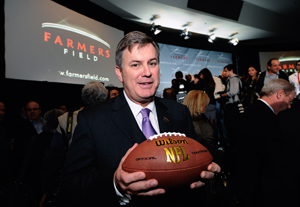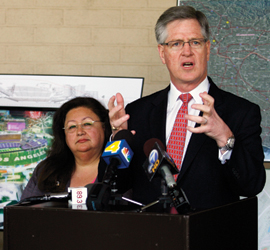With labor peace freshly assured in the NFL for the next decade, could the league finally return to Los Angeles, bereft of a team since 1994?
Periodically rising to the front of the NFL’s to-do list, Los Angeles in recent years has resided on the league’s back burner, a distant concern to the labor talks. That’s left two potential stadium sites, each pushed by a billionaire, to duke it out over which would be the best home for a team in America’s second-largest market.
In the absence of firm league guidance, however, and perhaps because the NFL believes competition results in the best deal, the tone and politics in Los Angeles have turned downright nasty.
“These guys throw things on the wall and see if they stick,” said Tim Leiweke, president and CEO of AEG, which is proposing a stadium in downtown Los Angeles.
“These guys” is developer Majestic Realty, which since 2008 has proposed a venue in City of Industry, a corporate haven a couple of dozen miles from the city center. Referring to John Semcken, Majestic’s vice president, Leiweke said, “this man has essentially gone out there and spun the truth and been wrong every time, and he knows nothing about our stadium.
“I don’t believe a word he says,” Leiweke added.
 |
GETTY IMAGES
AEG’s Tim Leiweke (top) has accused Majestic’s John Semcken (right) of lobbying state legislators against the Farmers Field project. |
 |
AP IMAGES
|
Leiweke accused Semcken of falsely taking credit for building Staples Center, which AEG owns and operates, and of never having developed a stadium or arena, an AEG specialty.
In an interview before Leiweke’s remarks, Semcken declined to comment on AEG’s competing project, although in the past he has criticized it publicly. And a Majestic spokesman, speaking for Semcken, said, “Majestic Realty is one of the most successful real estate firms in the country, and with John did all the negotiations with the city for Staples Center.”
Part of the acrimony stems from the Southern California rivalry between Majestic owner Ed Roski and AEG’s Phil Anschutz. The two developed Staples Center together before Roski declined to respond to capital calls and his share was diluted. And it also stems from, sources said, very different outlooks on the football question by the two men.
Majestic, said one source close to the situation, believes it has the solution to finally return football to Los Angeles, and the source said that had AEG not suddenly pitched its own plan last year, the NFL would have already chosen City of Industry. Meanwhile AEG believes, this source said, that City of Industry has had since 2008 to convince the NFL and lure a team, but has failed.
With few public funds available for new stadiums in California, the sites have bickered over which side would provide the biggest return, and which could truly get off the ground.
In the earlier interview, Semcken contended that because Roski controls the 600 acres in City of Industry outright, and as part of the stadium would be built against a hill, reducing steel costs, the project is more efficient. City of Industry’s billed price tag is $800 million, while Farmers Field, the AEG proposal, tops $1.3 billion, though it has a roof and a $700 million naming-rights agreement announced in February.
Leiweke points to the Farmers deal as evidence of his project’s viability and mocks Roski for not finding a title partner in City of Industry. Semcken’s spokesman responded that Majestic has not looked for naming rights, and believes it’s better to do so with a team in hand.
How much money a stadium can deliver is crucial. A team owner would likely need to pay a relocation fee to the league, and the developers could be constrained in what they offer a new team if stadium financing costs exceed projections. They are betting the lucrative Southern California market would solve this math.
“When no one in the market owns a team and there is clearly no substantial subsidy, you have an economic riddle which needs to be resolved before a team can come back to the market,” said Casey Wasserman, founder of Wasserman Media Group and a key Farmers Field supporter. “The riddle is twofold: How do you generate enough revenue to compel an NFL owner to relocate, while having enough economic activity left after a deal has been made with the team to finance a privately paid for stadium?”
For Wasserman the answer is simple: downtown Los Angeles and Anschutz’s enormous wealth. Leiweke brushed off suggestions that the Farmers Field project does not have as good a return by saying essentially it’s Anschutz’s money and so it doesn’t really matter.
However, that does leave a team banking on one man. And a football source said profit margins are not incidental.
“Yes, margin matters a lot,” this source said. “Generically, the margin available to the club/league is crucial. That is what pays the players.”
The Majestic spokesman, who asked that his name not be used, said, “In our building [the team’s take] will not be a fixed number, which makes it extremely attractive to potential owners. “It would place any team in the top five in the league [in revenue and profit], if not higher,” the spokesman predicted.
Whether that’s true is impossible to say, but what is true is that no NFL team seeking greener pastures has bitten on Roski’s long-standing offer: a minimum guarantee of revenue, control of the stadium operating company, but in return for a quarter of the team. Roski expects to make his money developing the land near the stadium, and from his stake in the club.
AEG is offering a more traditional model of a team as tenant guaranteed a certain amount of revenue, a model employed successfully at Staples Center.
The trend in the NFL, however, is for teams to control their own stadiums, so whether tenancy flies in the sport is unclear. Farmers Field would be housed next to a convention center and near L.A. Live and the Staples Center, forming another major part of the downtown entertainment district.
Meanwhile, emotions are raw over AEG’s recent state capital lobbying efforts seeking to win protection from environmental challenges to its project. In response, Semcken has personally met with legislators in Sacramento, the California capital.
“We won’t go forward if City of Industry is trying to stop us,” Leiweke said of the political equation. “They will do anything they can, including spinning the facts and making false statements.”
Roski in 2009 won from the state legislature such environmental cover for his project, and now AEG wishes for a similar arrangement. AEG officials believe Semcken is personally lobbying against them, and is upset he would do so when Majestic has the same deal.
The Majestic spokesman responded that politicians in Sacramento invited Semcken, and pointed out that when Roski won his victory in 2009, he had settled numerous environmental objections to his project. Farmers Field, by contrast, is not far enough along, the spokesman said, to even warrant objections.
Both sides are actively wooing teams that might want to relocate. With the regular season starting Thursday, however, there is little chance of movement on the issue because the NFL will not want word leaking that one of its teams is about to move.
“Nobody is going to make any commitment during the season,” Semcken said.
NFL Commissioner Roger Goodell told CBS Sports executives last month that the league would take its time carefully reviewing the two sites, said Sean McManus, CBS Sports chairman.
And that could mean unless the league is willing to put its weight behind one site soon, for some time, football in Los Angeles may remain out of bounds.
City of Industry
Where: 600-acre site 20 miles outside of Los Angeles
Size: 75,000-seat stadium
Cost: $800 million
Developer: Majestic Realty
Financing: Traditional capital structure similar to how Staples Center
was financed (Majestic expects need for only $350 million of debt).
Public funding: City of Industry has agreed to use a ticket tax to
pay for a new interchange.
Environmental report: Completed, and site has won immunity from
further environmental challenges.
Team role: Majestic owner Ed Roski would buy between 20 and
30 percent of the club; the club would then own the stadium and be
responsible for the debt. Majestic expects a $150 million grant from
the NFL and about $300 million of club-seat fees to defray the cost,
and cash from naming rights would cover a team's debt expense;
team would then capture the remaining revenue.
Naming rights: None signed yet.
When can construction begin: Majestic says it is shovel ready,
though AEG contends that Majestic has only schematics and not
construction plans, which would take longer to complete.
Completion target: 2014
Pros: Stadium could be built by 2014; little risk of legal challenges
impeding construction; more control of the stadium for the team.
Cons: City of Industry is considered in the middle of nowhere by
Angelenos, although it's only 20 miles from downtown Los Angeles;
Majestic seeks a 20 to 30 percent interest in the relocated team, which
appears to be a major stumbling block.
Farmers Field
Where: Downtown Los Angeles, next to convention center, L.A.
Live and Staples Center
Size: 72,000-seat roofed stadium, expandable to 76,250 seats for
special events such as the Super Bowl or NCAA Final Four.
Cost: $1.3 billion
Developer: AEG
Financing: Plan relies on AEG founder Phil Anschutz's wealth and
big-ticket revenue streams, including a $700 million naming-rights deal.
Public funding: None for the stadium, but some public bonding for
AEG work on the convention center
Environmental report: Scheduled to be finished by January
Team role: The team would be a tenant in the stadium with a guaranteed
revenue stream, similar to how Staples Center is run. Anschutz
would want a stake in the team, but the deal would not be contingent
on that happening.
Naming rights: Farmers Insurance
When can construction begin: Non-binding Memorandum of Understanding
completed with the city of Los Angeles underscores political
support for the project, but numerous hurdles remain.
Completion target: 2015
Pros: Glamorous downtown Los Angeles location next to other major
entertainment venues; roof would allow for many different events; AEG
is a major developer of sports projects.
Cons: Some believe the cost will be far higher; the trend in the NFL
is for teams to control their stadium, not be a tenant as envisioned
by AEG; without legislative protection from environmental lawsuits,
the project could be halted; potential traffic congestion downtown.





